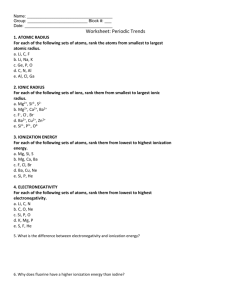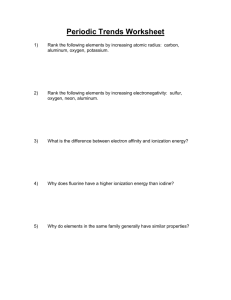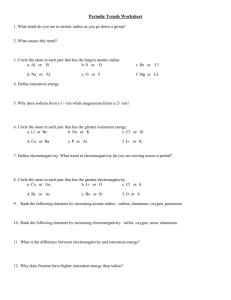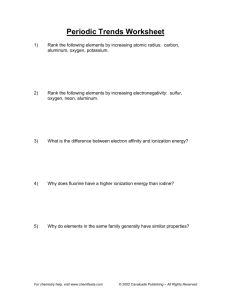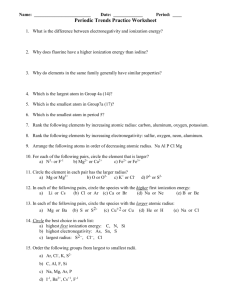Periodic Trends Worksheet
advertisement
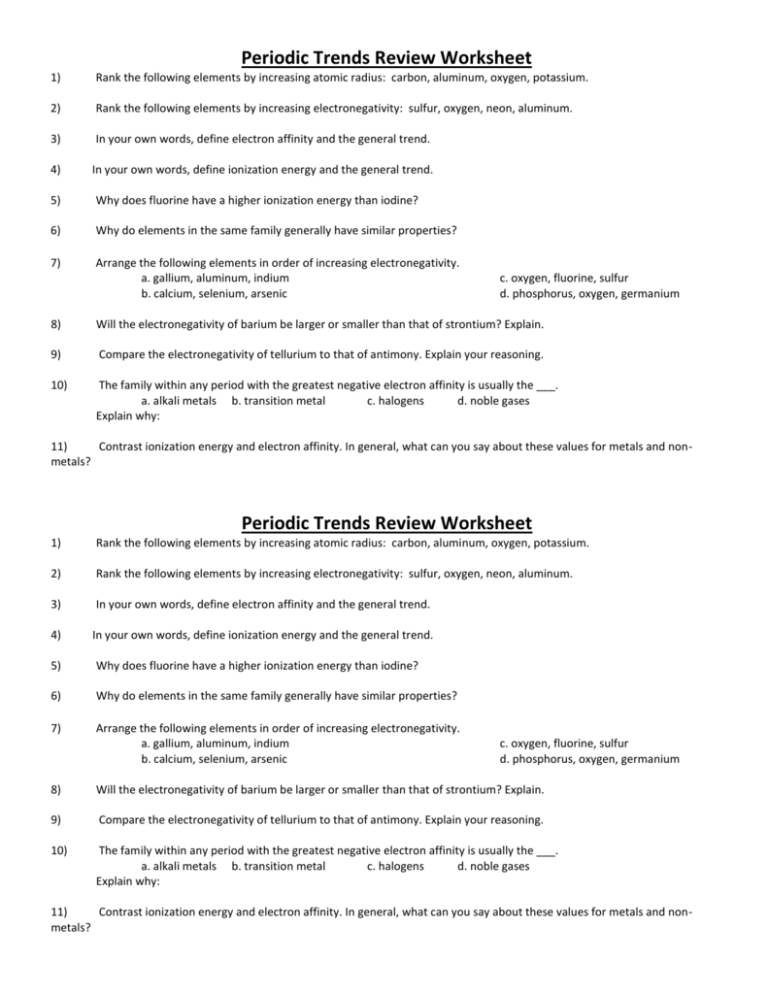
Periodic Trends Review Worksheet 1) Rank the following elements by increasing atomic radius: carbon, aluminum, oxygen, potassium. 2) Rank the following elements by increasing electronegativity: sulfur, oxygen, neon, aluminum. 3) In your own words, define electron affinity and the general trend. 4) In your own words, define ionization energy and the general trend. 5) Why does fluorine have a higher ionization energy than iodine? 6) Why do elements in the same family generally have similar properties? 7) Arrange the following elements in order of increasing electronegativity. a. gallium, aluminum, indium b. calcium, selenium, arsenic c. oxygen, fluorine, sulfur d. phosphorus, oxygen, germanium 8) Will the electronegativity of barium be larger or smaller than that of strontium? Explain. 9) Compare the electronegativity of tellurium to that of antimony. Explain your reasoning. 10) The family within any period with the greatest negative electron affinity is usually the ___. a. alkali metals b. transition metal c. halogens d. noble gases Explain why: 11) Contrast ionization energy and electron affinity. In general, what can you say about these values for metals and nonmetals? Periodic Trends Review Worksheet 1) Rank the following elements by increasing atomic radius: carbon, aluminum, oxygen, potassium. 2) Rank the following elements by increasing electronegativity: sulfur, oxygen, neon, aluminum. 3) In your own words, define electron affinity and the general trend. 4) In your own words, define ionization energy and the general trend. 5) Why does fluorine have a higher ionization energy than iodine? 6) Why do elements in the same family generally have similar properties? 7) Arrange the following elements in order of increasing electronegativity. a. gallium, aluminum, indium b. calcium, selenium, arsenic c. oxygen, fluorine, sulfur d. phosphorus, oxygen, germanium 8) Will the electronegativity of barium be larger or smaller than that of strontium? Explain. 9) Compare the electronegativity of tellurium to that of antimony. Explain your reasoning. 10) The family within any period with the greatest negative electron affinity is usually the ___. a. alkali metals b. transition metal c. halogens d. noble gases Explain why: 11) Contrast ionization energy and electron affinity. In general, what can you say about these values for metals and nonmetals? 12) What is the difference between electron affinity and electronegativity. 13) Why is it difficult to determine electron affinities for metals? 14) For each of the following sets of atoms, rank the atoms from smallest to largest atomic radius. a. Li, C, F d. C, N, Al b. Li, Na, K e. Al, Cl, Ga c. Ge, P, O 15) For each of the following sets of ions, rank them from smallest to largest ionic radius. a. Mg2+, Si4-, S2d. Ba2+, Cu2+, Zn2+ 2+ 2+ 2+ b. Mg , Ca , Ba e. Si4-, P3-, O2c. F-, Cl-, Br- 16) For each of the following sets of atoms, rank them from lowest to highest ionization energy. a. Mg, Si, S d. Ba, Cu, Ne b. Mg, Ca, Ba e. Si, P, He c. F, Cl, Br 17) For each of the following sets of atoms, rank them from lowest to highest electronegativity. a. Li, C, N d. K, Mg, P b. C, O, Ne e. S, F, He c. Si, P, O 12) What is the difference between electron affinity and electronegativity. 13) Why is it difficult to determine electron affinities for metals? 14) For each of the following sets of atoms, rank the atoms from smallest to largest atomic radius. a. Li, C, F d. C, N, Al b. Li, Na, K e. Al, Cl, Ga c. Ge, P, O 15) For each of the following sets of ions, rank them from smallest to largest ionic radius. a. Mg2+, Si4-, S2d. Ba2+, Cu2+, Zn2+ 2+ 2+ 2+ b. Mg , Ca , Ba e. Si4-, P3-, O2c. F , Cl , Br 16) For each of the following sets of atoms, rank them from lowest to highest ionization energy. a. Mg, Si, S d. Ba, Cu, Ne b. Mg, Ca, Ba e. Si, P, He c. F, Cl, Br 17) For each of the following sets of atoms, rank them from lowest to highest electronegativity. a. Li, C, N b. C, O, Ne c. Si, P, O d. K, Mg, P e. S, F, He
